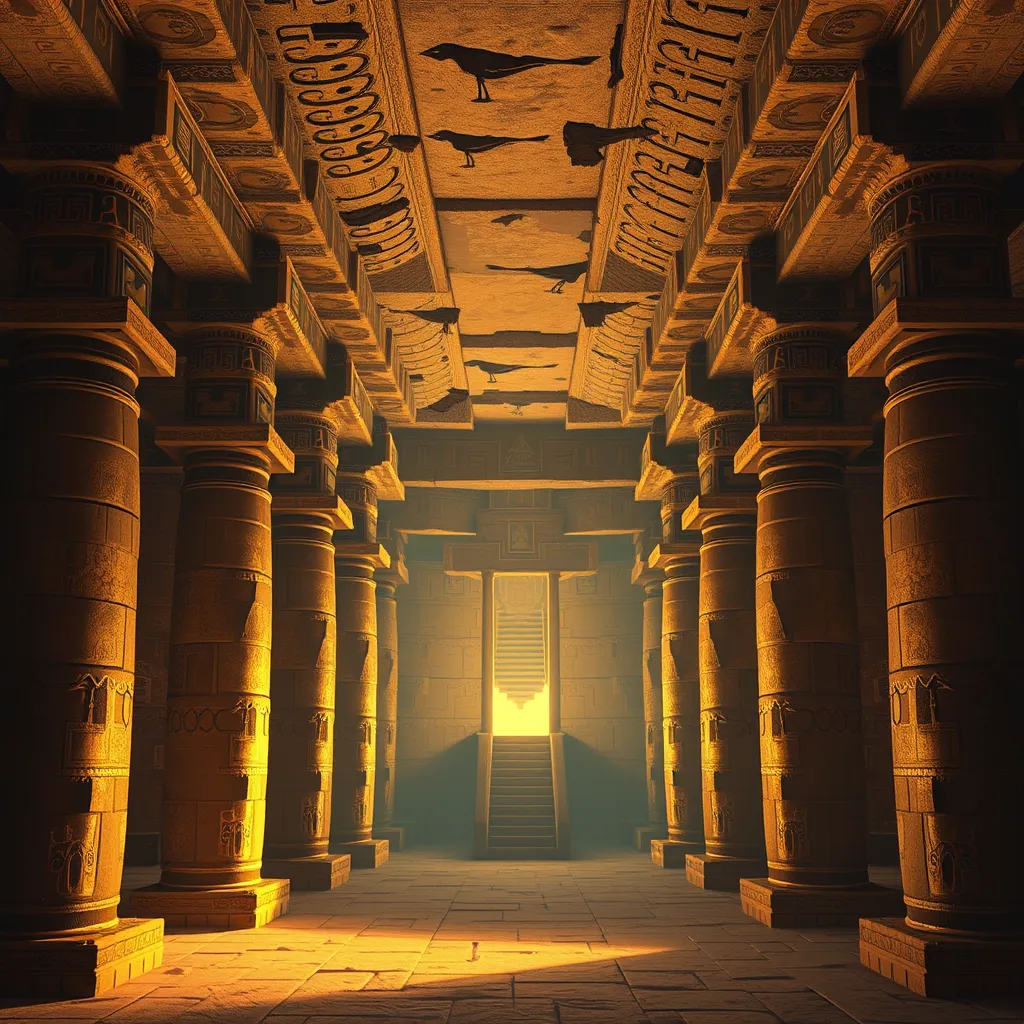The Duat: A Labyrinth of Trials and Triumphs
I. Introduction to the Duat
The Duat, known as the realm of the dead in Ancient Egyptian mythology, represents a complex afterlife scenario where souls undergo various trials before achieving eternal rest. It is a significant aspect of Egyptian culture, reflecting their beliefs about death, the afterlife, and the divine.
In Ancient Egyptian cosmology, the Duat is not merely a destination but a journey—a labyrinth filled with challenges and opportunities for triumph. This article aims to explore the intricate nature of the Duat, detailing the trials faced by souls and the eventual triumphs that can arise from these challenges.
II. The Structure of the Duat
The Duat is a richly imagined realm, often depicted in ancient texts and artwork as a complex geography filled with various landscapes, including rivers, mountains, and fields of reeds. Key locations within the Duat include:
- The Hall of Ma’at, where souls are judged.
- The Waters of Chaos, a dangerous and tumultuous area.
- The Fields of Iaru, a paradise for the worthy.
In this realm, gods and goddesses play crucial roles, guiding, judging, and sometimes challenging the souls who navigate its pathways. Deities like Osiris, the god of the afterlife, and Anubis, the god of mummification and the guardian of the dead, are pivotal figures within the Duat.
The Duat symbolizes the transition from life to death, embodying the Egyptians’ beliefs about mortality and the spiritual journey that follows. It reflects the cyclical nature of existence, emphasizing that death is not an end but a transformation.
III. The Journey Through the Duat
The process of death, according to Ancient Egyptian beliefs, was just the beginning of the soul’s journey through the Duat. Upon death, the soul would embark on a voyage across the Duat, which involved navigating various challenges and trials.
Souls faced numerous obstacles, including hostile creatures, deceptive apparitions, and treacherous landscapes. The Book of the Dead, a collection of spells and instructions for the deceased, was essential for guiding souls through these trials. This sacred text provided the deceased with the knowledge needed to overcome the challenges they encountered.
IV. Trials of the Duat
Within the Duat, souls faced several trials designed to test their worthiness for eternal life. Some of these trials included:
- Crossing the Waters of Chaos, filled with serpents and dangerous beings.
- Facing the judgment of the Weighing of the Heart ceremony.
- Encounters with mythological creatures such as the Ammit, a fearsome beast that devoured unworthy souls.
The Weighing of the Heart ceremony was particularly significant. In this ritual, the heart of the deceased was weighed against the feather of Ma’at, representing truth and justice. A heart that was lighter than the feather signified a life lived in accordance with Ma’at, allowing the soul to pass into the afterlife. Conversely, a heavier heart indicated a life of wrongdoing, resulting in the soul being devoured by Ammit.
V. Triumphs in the Duat
Despite the formidable trials, many souls successfully navigated the Duat, achieving triumph through their perseverance and righteousness. Stories of these successful journeys often highlight the rewards granted to the worthy:
- Entry into the Fields of Iaru, a paradise where the soul could enjoy eternal bliss.
- Rebirth, representing a new beginning and the continuation of the life cycle.
- Union with Osiris, the ultimate reward for those who passed the trials.
The concept of rebirth was central to Egyptian belief, symbolizing renewal and the cyclical nature of life and death. Triumph in the Duat allowed the deceased to transcend the limitations of mortal existence, achieving a divine status among the gods.
VI. The Duat in Art and Literature
The Duat has been a prominent subject in ancient Egyptian art, depicted in tomb paintings, papyrus scrolls, and temple reliefs. These representations often illustrate the journey through the Duat, the trials faced, and the rewards awaiting the worthy.
In literature, the Duat has influenced various texts, from the Book of the Dead to modern interpretations of Egyptian mythology. Key artifacts, such as the Coffin Texts and Pyramid Texts, provide insight into the beliefs surrounding the Duat, highlighting its importance in the spiritual life of the Egyptians.
VII. The Duat’s Legacy and Cultural Impact
The Duat’s influence extends beyond Ancient Egypt, resonating in various spiritual beliefs and practices throughout history. Its themes of judgment, trials, and the afterlife can be seen in many cultures, drawing comparisons to other concepts of the afterlife, such as the Greek Hades or the Christian Heaven and Hell.
Today, the fascination with the Duat continues, as modern interpretations explore its significance in understanding life, death, and the human experience. The symbolism of the Duat as a realm of trials and triumphs resonates with contemporary audiences, reminding us of the universal journey towards understanding and acceptance of mortality.
VIII. Conclusion
In summary, the Duat stands as a profound representation of the trials and triumphs inherent in the journey of life and death. It reflects the Ancient Egyptians’ complex beliefs about the afterlife, emphasizing the importance of living a moral life to achieve eternal peace.
By examining the Duat, we gain insight into the ancient Egyptian worldview, their spiritual practices, and the cultural significance of death and rebirth. The enduring legacy of the Duat serves as a powerful symbol of hope, transformation, and the eternal cycle of life.




